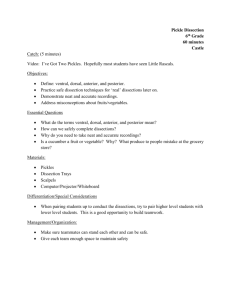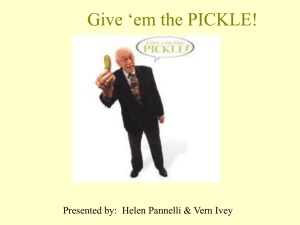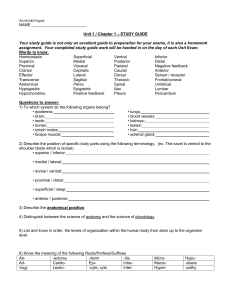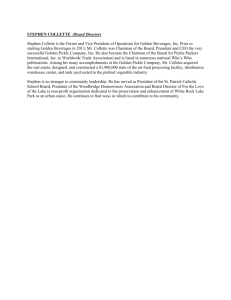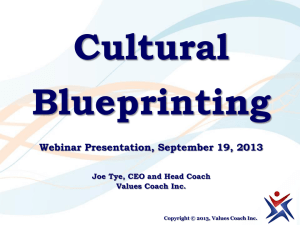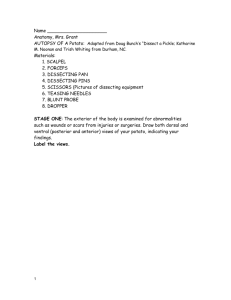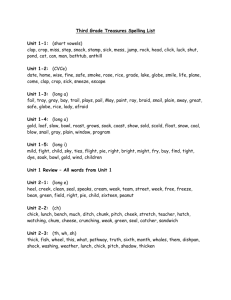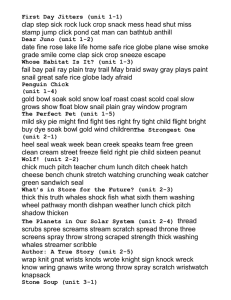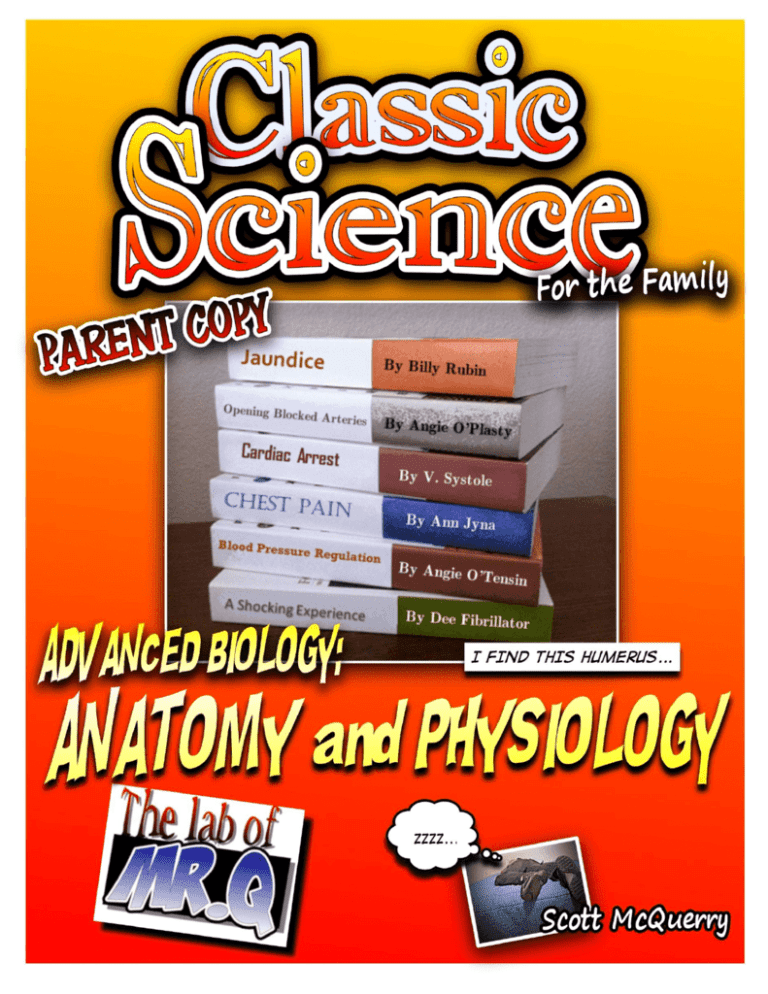
Page 1
Thank you so much for purchasing this
copy of
Advanced Biology: Anatomy and
Physiology
Hello there! Thank you so much for your willingness to bring this curriculum into your home.
This curriculum is the embodiment of two years of research and study. I’ve jumped head-first
into resources devoted to the concepts of Anatomy and Physiology to bring you the best for
your family. Please keep in mind that I have built this curriculum as an introductory course into
the basic concepts of anatomy and physiology. I am certain you will not be disappointed.
If you are new to the Classic Science series, the following information will give you an overview
of the coming year. For seasoned veterans out there, I want you to know that the format of
this new advanced series is comparable to the elementary and advanced curriculum you may
have been using. In addition, you will find many of the activities involve the use of the kitchen,
much like those found within the Advanced Chemistry book.
Before we begin, I want to thank each and every one of you who have helped guide me
throughout the years. Your time and effort will not be forgotten. I could not have achieved so
much without your help….
And now for something completely different…
The study of Anatomy and Physiology is a little different than some of the other scientific
disciplines. First of all, this concept is LOADED with vocabulary. I would highly recommend
purchasing a stack of notecards and begin generating flash cards for every vocabulary term
that is provided. Throughout the year, many of these definitions are used over and over again.
Write the word on one side and give yourself plenty of room on the other for notes. I’m really
not kidding here
Second, the weekly practice problems include an “Application Question” that should require a
short essay by the child. This may prove to be a challenge for many students – and that is
good! I would recommend allowing your child to utilize their notes in the answering of these
practice questions. The answers to each of these problems have been provided for you within
the parent edition of the textbook.
Weekly Timeline
This is a 36-week curriculum for children of ages 12-18. The weekly curriculum has been
arranged into two-week units (which is different from the elementary curriculum!) Each week
may be broken down into three separate days to make it easier for you to set up a schedule:
1) The first day of each week contains a reading assignment and a series of practice
problems for your child.
2) The second day can be spent reviewing the answers from the practice problems on the
first day, to review the flash cards for the week, AND to preview the weekly lab activity
which may require some preparation.
3) The third day is set aside for a lab activity that will reinforce the concepts being taught
that week.
Unit Quizzes, Quarterly Tests, and the dreaded
Final Exam (gasp!)
Each two-week unit contains a quiz in similar format to the weekly practice problems.
Students should study not only their vocabulary terms, but the labeled images throughout the
textbook as well.
Four quarterly tests have been created to further assess your child’s understanding of the
chapter concepts in addition to the unit quizzes. Your child will need time to prepare for these
tests as a full week has been provided for their administration:
Test #
1
2
3
4
FINAL EXAM
Week Chapters
8
16
24
32
36
1-7
8-14
15-21
22-28
1-31
Topics
Protection, Support, and Movement
Integration and Regulation
Fluid transportation
Absorption and Excretion
All topics including Reproduction
In addition, a “Conditions and Disorders” chapter has been included in the weeks before a
quarterly test. These include weeks 7, 15, 23, 31, and 35. The content for these chapters
addresses the question, “What can go wrong?” Their purpose is to introduce the student to
the common disorders and conditions involving the material within the previous units.
I would highly recommend setting up a regular schedule to prepare for the quarterly tests.
Breaking down each testing week into three or more separate days will make it easier to digest
(no pun intended) the large amount of vocabulary and its application to the human body. Here
are my suggestions:
1) The first or second days of each testing week should be spent reviewing the weekly
practice problems and unit quizzes. Do not forget to study the labeled diagrams within
each chapter as well.
2) One day should obviously be allowed for your child to complete the test.
3) An additional day needs to be set aside to evaluate the answers, correct any possible
mistakes within the notecards, and for an overall review. This material overlaps many
times throughout the year. The tests can be the most powerful learning tool throughout
the year.
A sample timeline can be seen below which contains the Unit Quiz and Quarterly Test schedule:
Weeks
Week 1
Week 2
Week 3
Week 4
Week 5
Week 6
Week 7
Week 8
Weekly Assignment
Unit 1: Chapter 1
Unit 1: Chapter 2
Unit 2: Chapter 3
Unit 2: Chapter 4
Unit 3: Chapter 5
Unit 3: Chapter 6
Chapter 7: What can go wrong?
Assessment
Unit Quiz
Unit Quiz
Unit Quiz
Quarterly Test
Unit 13 deals with the concept of the reproductive system and stands by itself. The unit quiz
can be found at the end of Chapter 31 (Week 35) which is a little different from the previous
unit quizzes; however, due to the small size of this unit, I felt it would be best to incorporate
the last three chapters into this quiz.
The final exam is comprehensive assessment covering the entire year. You may choose to allow
your child to complete this exam with or without notes; or, a single notecard can be provided
for any selective notes over topics which may have proven difficult throughout the year. I
would recommend a few days to prepare for this assessment.
Weekly Labs
I have attempted to place as many food-based labs into this book as possible. Please read the
labs before you begin your studies as some require preparations that cannot be performed by
the student. I promise you do not need an M.D. degree to prepare any of these activities!
To be perfectly honest, there is nothing more valuable than your health. The knowledge gained
from this curriculum added to the daily routine of preparing a meal can have amazing
educational opportunities for your child and your family. These labs have been designed to help
a student understand their own bodies and how it is affected through good nutrition and
exercise. It makes sense to incorporate
Future projects
Oh yes… there will be more books in the Advanced series! The best way to keep up-to-date on
this development is to sign up for my monthly LabNotes at www.eequalsmcq.com. I’m certain
you’ll love the free activities I provide each month for you and your family!
Once again, thank you all so much for your continual support and advice. I have read all of your
emails and have taken all of them to heart. I honestly could not have done this without your
help. Thank you. Thank you. Thank you.
And thank you for your tireless efforts to guide your children through the concepts of science.
Your hard work will not be forgotten in the young lives you are molding right now.
As I’ve said before - above all else, keep asking questions and keep searching for the answers!
And if you get stuck, I’m only a click away mrq@eequalsmcq.com
Take care,
Scott McQuerry
First of all thank you very much for choosing to use this book with your family. You will not be disappointed! I have
been asked by several families the same question, “Who are you and why are you doing this?” Without going into great
detail, E=McQ is owned, operated and stressed over by me. Yep… little o’ me. I am an educator by profession and
began working with homeschool families several years ago while offering free programs to area families to explore
various concepts in science. I guess I can’t stop doing what I love!
This product is the fruit of my 15-year labor in science education. Having worked with homeschool families over these
years I have gained an appreciation for your needs, struggles and wants. I could not make this curriculum any simpler
for your child to master the concepts of science. It is easy to follow, relatively cheap (I tried to keep it under the cost of
a tank of gas), and adaptable to various needs at home and as fun as humanly possible.
Like I said, I am an “army of one.” I have no problem with you using this one copy for your entire family. However, if
you give or loan this book out to another family you are putting a lot of pressure on me. If this happens too often, I may
not be able to continue producing this curriculum. I am not telling you to keep this curriculum a secret, but I have
provided some options for you should another family wish to use this curriculum:
If your friends are asking to borrow your copy to use throughout the year, please ask them to read this copyright
page and go to my website: www.eequalsmcq.com so that they may purchase their own book!
If you are reselling this curriculum please be aware that its value will diminish if many people are selling it for a
lower amount of money. This, too, puts pressure on little o’ me. If this is the path you choose, I hope you (or
the buyer) will consider providing a small contribution to support my continued work. I know it is impossible to
regulate this, but I am certain you will do the right thing!
If you are part of a CO-OP or other similar group of homeschool families, you may purchase licensing/copying
rights for use in your classrooms at a reduced rate. Please contact me at mrq@eequalsmcq.com for details.
Copyright©2013/Version 1.2: by Scott McQuerry All rights reserved. No part of this book may be used or reproduced
without the written permission of the publisher, except as explicitly stated below: The individual owner of this book
has my permission to make multiple copies of any materials for personal use within their own home. Reproduction of
these pages by schools, school systems teacher training programs for wider dissemination, cooperative groups of
homeschool or other families or by anyone for commercial sale, is strictly prohibited unless licensing for such has
been purchased from Scott McQuerry (mrq@eequalsmcq.com)
PAGES
Materials List
Week
Unit 1
1
2
3
4
5
6
1-7
Anatomical Orientation – “The Basics”
Chapter 1
Chapter 2
Body sections and Homeostasis
Cells and Tissues
Unit 2
Protection, Support, and Movement
Part 1 of 2
Chapter 3
Chapter 4
Integumentary System
Skeletal System
Unit 3
Protection, Support, and Movement
Part 2 of 2
Chapter 5
Chapter 6
Muscular System – Part I
Muscular System – Part II
8-23
24-39
40-49
50-68
69-80
81-92
Conditions and Disorders
7
8
9
10
11
12
13
14
Chapter 7
What can go wrong?
Test Chapters 1-7
Unit 4
Integration and Regulation Part 1 of 3
Chapter 8
Chapter 9
Nerves
Central Nervous System
Unit 5
Integration and Regulation Part 2 of 3
Chapter 10
Chapter 11
Peripheral Nervous System
Sense Organs
Unit 6
Integration and Regulation Part 3 of 3
Chapter 12
Chapter 13
Endocrine System – Part I
Endocrine System – Part II
93-108
109-122
123-136
137-154
155-166
167-183
184-193
194-206
Conditions and Disorders
15
16
Chapter 14
What can go wrong?
Test Chapters 8-14
207-221
222-234
Week
Unit 7
Fluid Transportation Part 1 of 3
17
18
Chapter 15
Chapter 16
Blood – Part I
Blood – Part II
Unit 8
Fluid Transportation 2 of 3
Chapter 17
Chapter 18
Cardiovascular System – Part I
Cardiovascular System – Part II
Unit 9
Fluid Transportation 3 of 3
Chapter 19
Chapter 20
Immune System – Part I (Lymphatic System)
Immune System – Part II (Immune Response)
19
20
21
22
235-245
246-262
263-271
272-284
285-294
295-304
Conditions and Disorders
23
24
25
26
27
28
29
30
Chapter 21
What can go wrong?
Test Chapters 15-21
Unit 10
Absorption and Excretion Part 1 of 3
Chapter 22
Chapter 23
Respiratory System – Part I
Respiratory System – Part II
Unit 11
Absorption and Excretion Part 2 of 3
Chapter 24
Chapter 25
Digestive System – Part I
Digestive System – Part II
Unit 12
Absorption and Excretion Part 3 of 3
Chapter 26
Chapter 27
Urinary System– Part I
Urinary System– Part II
305-321
322-334
335-345
346-360
361-372
373-390
391-401
402-412
Conditions and Disorders
31
32
33
34
Chapter 28
What can go wrong?
Test Chapters 22-28
Unit 13
Reproductive Systems
Chapter 29
Chapter 30
Male Reproductive System
Female Reproductive System
413-427
428-439
440-453
454-467
Conditions and Disorders
35
36
Chapter 31
Glossary
Credits
What can go wrong?
Final Exam
468-485
486-500
501-543
544
Page 1
Chapter 1: The Autopsy of a Dill Pickle
Four large whole dill pickles
2-3 foam meat trays or styrofoam
plates
Several straight pins
Several toothpicks
Sharp paring knife
Paper clip
Wire cutters
Chapter 2: Uncovering the Hidden Layers of an Egg
3-4 eggs (a couple for practice)
White vinegar
Drinking glass
Plastic wrap
2-3 eggs
Sewing needle or similar item
Soap and water
Baby powder
Baby aspirator, syringe, or bicycle
pump (optional)
Chapter 3: Plasticized Fingerprints
Two cotton balls
Baking soda (sodium bicarbonate)
Distilled water
Spoon
Clear drinking glass
Superglue
Small piece of foil
Gloves
Safety goggles
Crumpled piece of paper towel
(approximately the size of a fist)
Gallon freezer bag (clear)
Chapter 4: How Flexible is a Chicken?
Three chicken leg bones (or smaller
bones if possible)
Vinegar
Oven
Cookie sheet and foil
Small drinking glass
Small cooking pan
Page 2
Chapter 5: The Dissection of Dinner
Protective gloves and goggles
Scissors
Sharp knife
Paper towels
Tweezers or a toothpick
Uncooked whole chicken wing (not
“party wings” or wing sections)
Chapter 6: Gummy Chicken Tissue
Materials for roasting the chicken:
1 roasting chicken (~4lbs or 1.8kg); a
good quality bird is a must!
1 tablespoon table salt
¼ teaspoon pepper
1 tablespoon olive oil
½ cup chopped onion
¼ cup chopped celery
6 garlic cloves
1 bay leaf
1 large pinch of rosemary
2-3 tablespoons apple cider or white
vinegar
Additional materials:
Dutch oven or large stock pot with a
lid
Large spoon
Fine-wire strainer
Container with lid for drippings
Foil
Baking dish or carving board for
chicken
Large knife
Meat thermometer
Chapter 7: Putting your life on the “clothes” line
One clothespin (a tennis ball can also be used)
Large bowl of ice water
Timer or clock with second hand
Chapter 8: You’ve got some nerve!
Materials:
One large plastic baggie
One small plastic baggie
33 black beans*
31 red beans*
26 pinto beans*
20 lima beans*
*Any small objects may be used in place of beans as long as they are uniform in appearance.
Page 3
Chapter 9: Retrain Your Brain
Diagram sheets (attached)
Thick piece of cardboard
Pencil
Scissors
Small mirror
Timer/Watch with second hand
Book
Tape
Safety goggles with a flat face plate
Plastic or glass prism approximately 2in (5cm) in length
Basketball and hoop/Tennis ball or Crumpled paper and trash can – anything that
can be tossed (safely) inside or outside
Chapter 10: Scrambling the PNS and the CNS
Sugar
One lemon
Spoon
Glass of water
Saltine crackers
Tonic water with quinine
Four drinking glasses
Chapter 11: Mapping the Location of your Taste Buds
Blue food coloring
Magnifying glass
Paper cup
2 cotton swabs
Flashlight
One sheet of 3-hole punched
notebook paper
One sheet of blank white paper
Scissors
2-paper towels or napkins
Digital camera (optional)
Chapter 12: Clarifying Proteins
2 sticks (225g) unsalted butter, cut
into pieces
Small saucepan
Glass measuring cup (Pyrex)
Plastic wrap
Spoon
Page 4
Chapter 13: The Hidden Rhythms of our Body
Oral thermometer (a digital thermometer will likely work best that can provide
information to at least 0.1 degree accuracy)
Computer with Internet access
Paper and pencil
Chapter 14: Measuring your blind spot
One 3 X 5 inch (8 x 13 cm) card or other stiff paper
Black and red markers
Pen
Meterstick
Chapter 15: Centrifuging the Components of Blood
Bicycle
Tape
1% milk
Vegetable oil
Red food coloring
Blue Food Coloring
Mixing container and spoon
Metric ruler
Three small clear plastic bottles with
caps
Chapter 16: The Hidden Reactions of Typing Blood
Twenty 3oz (89mL) paper cups
8 toothpicks
Marker
One cup (250mL) skim milk
Water
Red and green food coloring
1/2 cup (100mL) vinegar
12 eye droppers
Measuring cup
Chapter 17: Welcome to the Lub Dub Club!
Scotch tape or Sellotape (UK)
Old water/soda bottle with lid
Scissors
Bowl or tub of water
Drill with 0.4in (1cm) bit (optional)
Page 5
Chapter 18: The Mysterious Shrinking Veins
Stopwatch or clock with a second hand
Camera (optional)
Chapter 19: Simulating the most frightening form of
defense imaginable
1 plastic shopping bag
1 pair of scissors
15 cm of string, large rubber band, or tape
4 pieces of wrapped candy, peanuts, raisins, or other item
Chapter 20: Homemade Yogurt
1.75 cups (~91 grams) powdered whole
milk
4 cups (946mL) warm water (between
43-51 °C or 110-125 °F)
1/3 cup (80 grams) of plain yogurt
with active and live cultures
Five (5) one-cup containers with lids
Mixing bowl and whisk
Small cooler or insulated lunch
container
Fresh fruit
Spoons
Chapter 21: Stowaways on our Phalanges
4 packages (4oz/113g) plain gelatin
Four cups (946mL) cold water
Eight teaspoons (33.6g) sugar
Four beef bouillon cubes
*Ten foil muffin cups
*Muffin pans
Ten sealable sandwich bags
Sauce pan and stove
Aluminum foil
Measuring spoons
Permanent marker
*If muffin cups are not available, you can use disposable plastic cups
Page 6
Chapter 22: Breathing Acid and Scuba Diving 101
Distilled water
Drinking glass
Red cabbage
Drinking straw
Knife
Small empty water bottle
Large pot
Baking soda
Fine mesh strainer or coffee filter
Large syringe (10-60mL) *the largest syringes can be found at pharmacies, automotive
stores (for bleeding fluids from a car), or BBQ retailers (for injecting marinades)
Chapter 23: Homemade Spirometer
Three-liter soda bottle with cap
~2 foot (61cm) length of plastic tubing
Measuring cup
Bucket/pan with a 3+ liter volume
Chapter 24: Anti-gravity beverages
Two small kitchen funnels
Plastic tubing
Tape (optional)
Drinking glass
Water
Stopwatch or clock with second hand
Ruler
Two volunteers of varying heights
Chapter 25: Encapsulating the Digestive System
1/4 cup (60mL) flour
1/8 cup (30mL) corn starch
1/4 cup (60mL) sugar
1/8 cup (30mL) vegetable oil
1 paper plate
4 small paper or plastic bowls or cups
1 clear plastic cup
1 cup (240mL) clear diet soda
1 small plastic spoon
2 pieces of color-coated candy (Runts
or Skittles work well)
Timer
Chapter 26: Neutralizing an Acid
16oz (473mL) baking soda
8oz (236mL) white vinegar
One gallon (3.8L) of distilled water
1 eyedropper
3 clear drinking glasses
One can of clear soda (7-up, Sprite,
etc.)
Page 7
Chapter 27: Modeling the Nephron
Cornstarch
Two drinking straws
Two sealable baggies
Large clear disposable glass/plastic
Iodine
bowl
*Do not use any of your good bowls for this lab!
Chapter 28: Homemade Greek Yogurt
Strainer
Large bowl
Several paper towels
Four cups plain regular yogurt
Chapter 29: Licorice Meiosis
One white sheet of paper
Four sealable baggies
Pencil
String
Plastic wrap
One full can of fruit, vegetables, etc.
Cocoa (optional)
Scissors
Scotch tape
Two red and black pieces of licorice
Chapter 30: The Genetics of Mr. and Mrs. Peep
1
1
1
1
bag of large white marshmallows
bag of small colored marshmallows
container of push pins (red and blue)
container of thumb tacks
5+ pipe cleaners (cut in half)
1 box of toothpicks
Chapter 31: Adherence rates and HIV
Twenty (20) individual servings of any powdered drink (Kool-Aid, Crystal light, etc.
are all acceptable)
One box each of TicTacs in the following flavors: Spearmint, Cinnamon, Citrus, and
Wintergreen; and two boxes of orange TicTacs*
Drinking glasses/spoons
Two reliable assistants
*Any substitution would be acceptable for the candies
Chapter 1: Page 8
Chapter 1: Page 9
Four large whole dill pickles
2-3 foam meat trays or styrofoam plates
Several straight pins
Several toothpicks
Sharp paring knife
Paper clip
Wire cutters
12CLS6.2 Organisms have behavioral responses to internal changes and to external stimuli.
Responses to external stimuli can result from interactions with the organism’s own species and
others, as well as environmental changes; these responses either can be innate or learned.
Chapter 1: Page 10
anatomy
anterior (ventral)
coronal (frontal)
plane
distal
external (superficial)
homeostasis
inferior (caudal)
interior
lateral
medial
negative feedback
physiology
planes of reference
positive feedback
posterior (dorsal)
proximal
sagittal plane
superior
transverse plane
the study of the body’s physical structures
directional term meaning "toward the front"
plane of reference which divides the body into anterior
and posterior portions
away from the trunk of the body
toward the surface of the body
the property which regulates our internal environment
to create a stable and constant set of properties
directional term meaning "toward the bottom"
away from the surface of the body
away from the midline of the body
toward the midline of the body
occurs when the response to a stimulus (feedback)
results in a reversal of the direction of change
the study of the body's functions
a set of three planes (imaginary flat surfaces) passing
through the body used to identify specific locations in,
on, and around the body
occurs when the feedback results in an increase of the
change
directional term meaning "toward the back"
toward the trunk of the body
plane of reference which divides the body into right
and left sides
directional term meaning "toward the top"
plane of reference which divides the body into inferior
and superior portions
Chapter 1: Page 11
What is the difference between anatomy and physiology?
Anatomy is the study of the body’s physical structures. Physiology is the study of
the body's functions.
How is negative feedback important for the human body?
Negative feedback allows the body to go through homeostasis by reversing an
action taking place within the body.
Which is more prevalent within the human body - negative or positive
feedback?
Negative feedback is more prevalent within the human body.
Are the feet superior or inferior to the chest?
The feet are inferior to the chest.
Which plane of reference which divides the body into inferior and superior
portions?
The transverse plane divides the body into upper and lower halves of the body.
Chapter 1: Page 12
Chapter 1: Page 13
Vocabulary Review
1)
planes of reference
11)
coronal (frontal) plane
2)
lateral
12)
transverse plane
3)
interior
13)
sagittal plane
4)
distal
14)
homeostasis
5)
positive feedback
15)
anatomy
6)
negative feedback
16)
physiology
7)
posterior (dorsal)
17)
medial
8)
inferior (caudal)
18)
external (superficial)
9)
anterior (ventral)
19)
proximal
10)
superior
Multiple Choice
1) A
4) A
2) C
5) D
3) E
6) D
Application Questions
a. Inferior (caudal)
b. Anterior (ventral) and external (superficial)
c. Proximal and superior
d. Medial and anterior
Chapter 1: Page 14
Four large whole dill pickles
2-3 foam meat trays or styrofoam plates
Several straight pins
Several toothpicks
Sharp paring knife
Paper clip
Wire cutters
PARENTS! Be certain to check out
the Pre-lab preparation for this
week’s activity. This lab requires a
little planning!
Chapter 1: Page 15
The Autopsy of a Dill Pickle
“The sight was horrible. Relish everywhere….”
The dissection of a pickle will be used to review planes of reference and
directional terms for the human body.
Materials:
Four large whole dill
pickles
2-3 foam meat trays or
styrofoam plates
Several straight pins
Several toothpicks
Sharp paring knife
Paper clip
Wire cutters
Pre-lab preparation (for parents):
Each of the four pickles will represent an individual undergoing an autopsy. Insert
four toothpicks into each pickle to represent the arms and legs of the individual
and attach two beads for eyes using pins. In addition, cut three small pieces of
metal from a paper clip (0.2 inches or 5mm in length). You will use one of these
pieces in Pickle #1 and the others with Pickle #4.
Feel free to venture beyond the following instructions to be as creative as you
wish; however, the following images, descriptions, and answer keys will provide you
an easy way to assess your child’s understanding of the planes of reference and
directional terms for the human body. You may prepare the “bodies” in the
following manner:
Chapter 1: Page 16
Pickle #1
Insert one of the small pieces of metal within the upper left portion of pickle #1.
This should be placed on the front side of the pickle. Do not bury this piece much
below the surface. It may be beneficial to make the opening much larger in order
to be visible during the autopsy.
In addition, make a large (noticeable) cut through the lower right section of the
pickle on its back side.
Pickle #2
Make one large cut in the lower right section on the front side of the pickle; one
cut within both the right and left sides of the upper back side; and, another cut in
the upper left area on the front side of the pickle.
Chapter 1: Page 17
Pickle #3
Break the lower right and upper left toothpicks in half. Make one large cut in the
lower left area on the back side of the pickle.
Pickle #4
Insert one of the remaining pieces of paper clip within the upper right portion of
the pickle on its back side. The last piece of metal is to be placed in the front
side of the pickle on its lower right side.
Chapter 1: Page 18
Procedure (for students):
In this activity, you will assume the role of a medical examiner with the
responsibility of performing an autopsy on four individual patients. Each of these
patients has perished by different means. It is up to you to examine and record
all of your findings within the Autopsy Report.
Examine both the posterior (dorsal) and anterior (ventral) surfaces of your
patient for distinguishing marks such as wounds or scars from injuries or
surgeries. Draw and label your findings in the External Observations section of
your Autopsy Report.
Rotate your patient so that its anterior side is up. Fasten your patient to the
plates by inserting a pin into the upper superior and lower inferior sections of the
body.
Use the paring knife to open the ventral “body
cavity” of the patient by making a deep I-shaped
incision as shown in the picture on the right:
The incision should allow you to open this cavity much
like hinged doors. You may need to pin down the
sides in order to keep the cavity open.
Draw and label your
patient at this time
within the Internal Observations section of your
Autopsy Report. Note any foreign objects and
their location. The following will provide you with a
sample report - “A metal object was found in
anterior section of the patient in the left superior
area, medial to the shoulder.”
Your report must include locations using the
following terms: superior or inferior, anterior or
posterior, and left or right sides.
Chapter 1: Page 19
Explanation:
A real autopsy would include a more thorough examination of the height and
weight of the individual as well as the cause of death, presence of drug use, or the
identification of any congenital defects. This activity is designed to identify the
basic directional terms for the locations of the human body. These directional
terms are based upon the directional terms for the human body:
Term
Definition
Superior
Toward the head; toward the top
Away from the head; toward the
bottom
Toward the front
Toward the back
Toward the midline of the body
Away from the midline of the body
Away from the surface of the body
Toward the surface of the body
Towards or near to the trunk of the
body
Away from the trunk of the body
Inferior (caudal)
Anterior (ventral)
Posterior (dorsal)
Medial
Lateral
Internal (Interior)
External (superficial)
Proximal
Distal
Chapter 1: Page 20
Autopsy Report
Locate and draw the following planes of reference within each drawing:
Sagittal plane, Coronal plane, and Transverse plane
In addition, label the following pictures with the following directional terms:
Anterior, Posterior, Superior, Inferior
External examination:
Pickle #1
Dorsal View
Ventral View
Chapter 1: Page 21
Pickle #2
Dorsal View
Ventral View
Pickle #3
Dorsal View
Ventral View
Pickle #4
Dorsal View
Ventral View
Chapter 1: Page 22
Internal examination:
Pickle #1
Pickle #2
Pickle #3
Pickle #4
Chapter 1: Page 23
Answer key:
Pickle #1
Small piece of metal found within the left superior (upper half) and anterior
section (front side) of the body. Large cut found in the right inferior (lower half)
and posterior (back side) of the body.
Pickle #2
One large cut found in the right inferior (lower right) and anterior (front side).
One large cut found in the right superior (upper right) and posterior (back side).
One large cut found in the left superior (upper left) and posterior (back side).
One large cut found in the left superior (upper left) and anterior (front side).
Pickle #3
The right leg and left arm are broken. One large cut found in the left inferior
(lower left) and posterior (back side) of the pickle.
Pickle #4
Small piece of metal found within the right superior (upper half) and posterior
section (back side) of the body. Another small piece of metal was found within
the right inferior (lower half) and anterior (front side) of the pickle.

